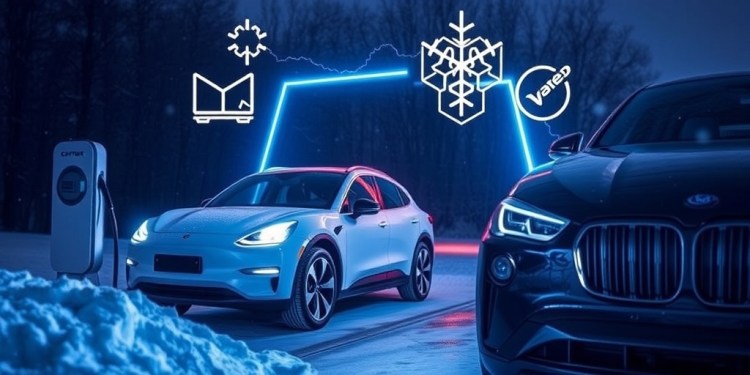At the forefront of this innovation is Neil Dasgupta, an associate professor of mechanical engineering and materials science at the University of Michigan. Dasgupta, who is also a corresponding author for the study published in the prestigious journal Joule, articulates a vision where this new manufacturing approach could be seamlessly integrated into existing production lines without necessitating extensive modifications to current facilities. This is particularly significant in an industry that is continuously evolving to meet the demands of consumers who prioritize efficiency and reliability.
The researchers achieved a remarkable feat: demonstrating a pathway that enables extreme fast charging of lithium-ion batteries even at low temperatures of 14°F (-10°C) without compromising the energy density of the cells. Traditional lithium-ion batteries suffer from performance issues in cold conditions due to the sluggish movement of lithium ions between electrodes, a process that is reliant on liquid electrolytes. This slow movement translates to reduced power delivery and extended charging times, which can further frustrate consumers in colder climates.
The modified batteries developed by the Michigan researchers exhibit a radical improvement in charging speed, boasting a performance increase of up to 500%. Such advancements are significant for consumers who have experienced the difficulties of charging EVs during freezing temperatures, where conventional batteries can become inert and fail to deliver the anticipated power output. This breakthrough hinges on addressing the formation of lithium plating that occurs on battery electrodes, a phenomenon that detracts from the overall performance and longevity of the cells.
To prevent lithium plating, Dasgupta’s team introduced a novel coating of lithium borate-carbonate, which is only about 20 nanometers thick. This glassy material effectively suppresses the undesirable chemical layer that typically builds up on the electrode surfaces, allowing for unhindered passage of lithium ions during the charging process. The integration of this protective coating, paired with pre-existing modifications that enhance pathways within the battery anode, produced an unparalleled charging experience. It allows the batteries to maintain 97% of their capacity after being subjected to rapid charging cycles in frigid conditions.
Historically, automotive manufacturers have attempted to counteract the issue of reduced battery capacity in cold weather by increasing the thickness of electrodes to store more energy. However, while this method may extend the range, it simultaneously creates challenges, making it harder for lithium ions to migrate during the charging process. Consequently, it generates a trade-off that affects both charging speeds and overall battery performance, leading to consumer dissatisfaction.
In their explorations, the researchers compared the behavior of the chemical layer formed on electrode surfaces to that of butter at different temperatures. By demonstrating that lithium ions could navigate this layer with relative ease when at higher temperatures, they drew a parallel to the challenges faced in cold scenarios, where the same layer becomes a barrier to efficient ion movement. By exploring mechanisms to keep this layer from forming altogether, they developed a strategy that enhanced charging under low-temperature conditions.
The implications of this research extend far beyond laboratory findings, as it is well-known that consumer sentiment towards EVs can shift based on various external factors, including winter performance. A recent survey by AAA highlighted that interest in electric vehicles can wane during seasons where range reduction and sluggish charging become notable issues. In fact, the percentage of U.S. adults who indicated they were likely to purchase an EV declined from 23% to 18% from 2023 to 2024. This downward trend underscores the importance of addressing real-world performance concerns during colder months.
Looking ahead, the team is actively pursuing the next steps in transforming their lab findings into scalable production methods. Their research is supported by the Michigan Economic Development Corporation through the Michigan Translational Research and Commercialization Advanced Transportation Innovation Hub, indicating strong institutional backing for advancements in this technology sector. They aim to translate their innovations into factory-ready processes that manufacturers can adapt to meet consumer demands.
Arbor Battery Innovations has already licensed the innovative channel technology arising from this research. Their collaboration showcases a vital connection between academia and industry, allowing for the practical application of cutting-edge research and its contribution to electric vehicle technology. Both Dasgupta and the University of Michigan are financially vested in this commercialization effort, further emphasizing their commitment to driving advancements in battery technology.
The research demonstrates a significant leap forward in addressing the challenges that currently inhibit the widespread adoption of electric vehicles. By focusing on improving lithium-ion battery performance in low temperatures, the team not only enhances the charging experience but also stands to extend the practicality of EVs in a variety of climates. As this technology progresses toward widespread implementation, it promises to catalyze a new era of electric vehicles that are efficient, reliable, and capable of meeting the demands of modern consumers.
Subject of Research: Modified manufacturing process for electric vehicle batteries
Article Title: University of Michigan Engineers Develop Breakthrough in Cold Weather Electric Vehicle Battery Technology
News Publication Date: October 2023
Web References: University of Michigan
References: Joule
Image Credits: University of Michigan
Keywords
Electric vehicles, lithium-ion batteries, fast charging, cold weather performance, energy density, battery manufacturing technology, Michigan researchers, lithium plating prevention, vehicle range, consumer attitudes toward EVs.
Tags: advancements in electric vehicle technologychallenges in electric vehicle adoptionconsumer concerns about EV performanceefficient battery production techniqueselectric vehicle battery technologyenergy density in extreme temperaturesfast charging in cold weatherlithium-ion battery manufacturing improvementslow temperature battery performancemanufacturing methods for EV batteriesNeil Dasgupta battery innovationUniversity of Michigan EV research






